| |
|
|
The City of Greater
Sudbury is conducting a
review of the Parks,
Open Space & Leisure
Master Plan which was
established in the year
2004.
A survey that was
completed by 500 local
residents provided some
important information
and the staff considered
input from a series of
public open houses
during May, one of which
was held at the Howard
Armstrong Recreation
Centre on May 13, 2014.
After
reviewing the results of
the survey and the
public input, staff will
present a draft plan to
Council on June 16,
2014.
The new Master Plan will
provide guidance and
direction with respect
to parks, recreation and
leisure needs of the
community for the next
twenty years. It is
important to get this
plan right since it will
become the official
policy guideline that
will bring us closer to
our big goals in this
area.
If after you read the
following report you
would like to provide
the City with some
additional input, send
your email to Chris
Gore, Manager of
Community Partnerships
at
chris.gore@greatersudbury.ca
Download Poster
2004 Leisure Master Plan |
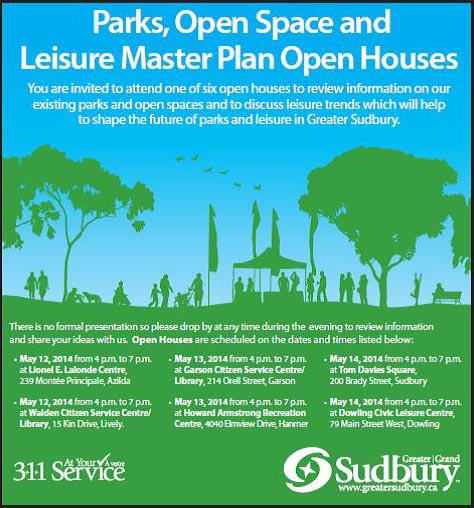 |
|
|
| |
|
ONLINE
SURVEY RESULTS
PARTICIPATION SURVEY
The chart below provides the data collected from
500 online surveys completed by Greater Sudbury Households. It is
important to note that the average number of members in the households
was somewhere in the 3.5 range, which indicates that a lot of people
with children still living at home completed the survey. This makes the results even more
significant. Consider the following points and remember that this part
of the survey asked each person to indicate their participation in
selected leisure activities during the past 12 months.
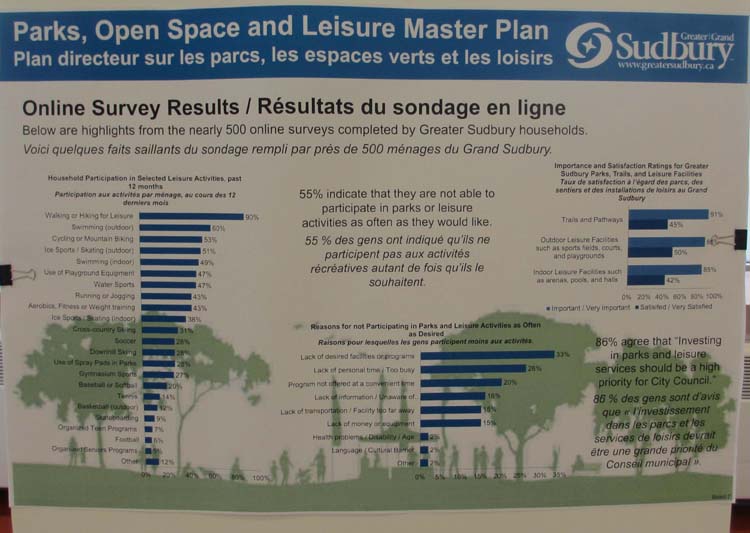
|
1.
Notice
that 90% of the participants participated in walking or hiking for
leisure during the past 12 months. This is significantly higher than the next popular activity
which was outdoor swimming, likely at camp or a public beach., but still
60% of the survey participants indicated that they has gone swimming
outdoors. The third
most popular activity was cycling or mountain biking. All three of the
top activities are things that the entire family can participate in at
the same time and they are
all done outdoors. There is little if any cost to take part in the
activity.
2.
It is
interesting to see that ice sports/skating outdoors was participated in
by 51% of the people filling out the survey while only 38% participated
in the same activity on indoor ice surfaces. Once again the preference
seems to be on skating or playing ice sports outside, likely on
neighbourhood playground rinks. Again, this is something the entire
family can take part in and there is little or no cost.
3.
When you
consider the ranking of the activities, it is clear that most of the
people filling out the survey have taken part in many activities that
are intended to improve their level of fitness and health and they are
also the kinds of activities that they can choose to do whenever they
wish and with the entire family. These activities are flexible with
respect to schedule and many of them are done outside.
4.
Over half of
the people doing the survey wished that they are not able to participate
in activities as often as they would like and the two top reasons for
not participating was a lack of desired facilities or programs and a
lack of personal time. I would suggest that the main reason was likelky
a lack of personal time.
5.
When it comes
to a comparison of the importance and level of satisfaction of several
categories, it is interesting to note that with respect to Trails and
Pathways, 91% of the people doing the survey felt the Trails and
Pathways were important
while only 45% were actually satisfied with the trails and pathways.
This is something that the City should seriously consider when it
comes to improving the trails and pathways in the region. If so many
people feel that the trails and pathways are important, while half of
them feel that they are not satisfied with the trails and pathways, then
something must be done to improve the level of satisfaction.
6.
Another
interesting point is that 88% of the people feel outdoor leisure
facilities such as sports fields, courts and playgrounds are important,
but there is only a 50% satisfaction level. Again, this is significant
because the outdoor fields and playgrounds are easy to access and can be
accessed whenever a person has time. This high ranking in importance and
low satisfaction level cannot be allowed to continue. Something must be
done to increase the satisfaction level since so many people are
actually participating in these venues.
7.
Again, it is
important to note that many of the activities are outside, can be
adapted to an individual’s schedule, are very low cost to take part in,
and can involve the entire family. We are a family –focussed,
outdoor-focussed society. This signals a need for a shift in priorities
with respect to our long term Master Plan. The need for a large, central
multi-purpose complex does not seem to fit with the results of the
survey. Nor does it fit with the general trends among all demographics.
SUPPORT FOR ADDITIONAL
SPENDING
The survey found
that 86% of those completing the survey felt that investing in parks and
leisure services should be a high priority for Council. They were then
asked for which parks and leisure facility types they would support
spending additional municipal money. The results her were once again
significant.
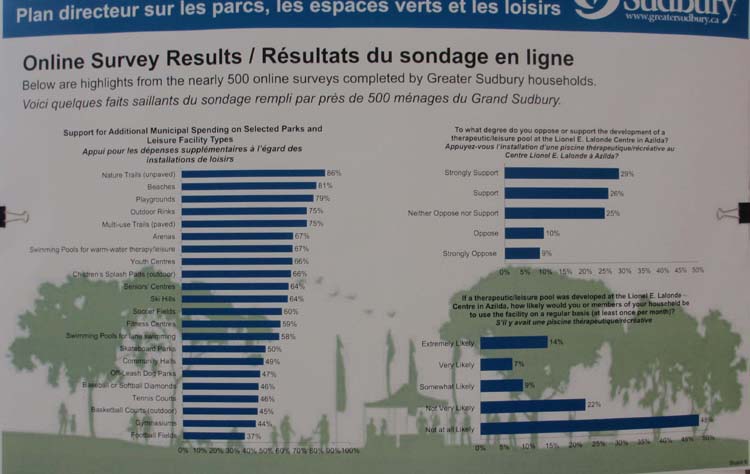 |
| |
1.
Unpaved nature trails came in at number
one with 86% of the people selecting this as something for which they
would support spending more municipal money. In fact, the top five items
selected were all outdoor facilities, with playgrounds and outdoor rinks
included. Clearly the priority among residents of Greater Sudbury is in
the area of outdoor activities that can be accessed according to an
individual’s schedule and can be enjoyed by the entire family.
2.
Spending more money on arenas ranked in
the same grouping as youth centres, outdoor children’s splash pads,
senior centres and ski hills. These are all activities that address the
needs of very specific interest groups, but still they fall within the
category of activities that people can use according to their own
personal schedules on a drop-in basis. We have become a society that
have such diverse needs and interests that it getting impossible to get
everyone together at the same time in any given activity. People have
time to participate, but not at the same time.
3.
It seems clear that there is more
interest in participation rather than being a spectator and certainly
more interest in outdoor activities vs indoor activities. Finally, there
is definitely more interest in activities that can be performed during
one’s entire life than on those that are reserved mostly for the young.
|
|
PARKS AND LEISURE TRENDS
The Master Plan is going to be developed by taking into consideration
the results of the online survey as well as the input from the public
sessions. However, the
public contributions are then going to be used together with the
research that has been done by City Staff with respect to the Parks and
Leisure trends that fall under a number of important categories which
have been designated by staff, including demographic shifts, busy
lifestyle, facility provision, and healthy communities.
The information that is contained in the following two charts likely
gives a good indication of the foundation and fundamental principles
that will help form the new Master Plan for the next ten to twenty
years. I would like to examine a few of the principles that have not
only been identified as trends by
City staff, but which have also been pointed out as high
priorities among the 500 people who participated in the online survey.
It appears as if both City Staff and the general public are on the same
page with respect to the focus of Leisure and Recreation during the next
decade.
-
We do have an aging population that is concerned with wellness
activities designed to keep them physically and emotionally fit.
There is a move being observed among older adults (50 to 70 years)
away from traditional activities that were popular among our current
seniors who are somewhat older.
-
There is an increasing focus on family and social activities,
especially those that involve the outdoors and community gatherings.
-
There is a shift towards activities that do not present financial
barriers to participation. More families are opting for the
activities where they can involve their children at low or no cost
in order to remove the need to limit participation for financial
reasons.
-
Because of the busy lifestyle of most families with both parents
working outside of the home, we have been observing a decreased
interest in organized sports and a greater emphasis on drop-in,
self-scheduled activities for the entire family. One of the reasons
for this is because with such a high demand for prime-time
activities, most organized sports venues are unable to accommodate
the demand and people who still participate in organized activities
often have to do so in less desirable times of the evening.
-
Despite the movement towards outdoor leisure activities, the public
also wants indoor options such as walking tracks, swimming pools and
fitness facilities that can be used year-round despite the weather.
-
When it comes to recreation facilities, there is a recognition that
our existing facilities are old and in need of major repair, but
financially unless there are some partnerships formed with the
private sector, it may be impossible to fund the construction of new
facilities. Especially since the demand now is for multi-use
facilities that are more flexible and meet the specific needs of
more people, but are very expensive to build.
-
There is a great demand for activities that promote healthy living,
such as walking trails connecting different destinations and
neighbourhood facilities
where people can walk from home to access.
-
From a budgetary standpoint, municipalities are faced with a
conundrum. There is greater focus on financial sustainability and
cost recovery, while at the same time the demand is even greater to
provide activities that are low to no cost in order to remove the
financial barriers to participation. It means that the new Master
Plan will need to focus on the provision of facilities that promote
activities which can be maintained at low cost and are mainly
outdoors. Walking trails, bike paths, swimming beaches, and
neighbourhood parks must take on a much higher priority than ever
before. There must also be a focus on providing indoor swimming,
fitness rooms, and walking tracks. All of this must be done while
recognizing the need for cost recovery, but the cost recovery will
have to be met from other than the users of the facilities. This
means more work with the private sector and also finding a different
way of delivering the services.
MASTER PLAN PRESENTED TO COUNCIL ON JUNE 16, 2014
The Master Plan will be presented to City Council for the first time on
June 16, 2014. It is sincerely hoped that there will be at least the
summer months for the public to review the new Master Plan proposal.
This is going to become the blueprint for the next ten years and it is
important that we get it right.
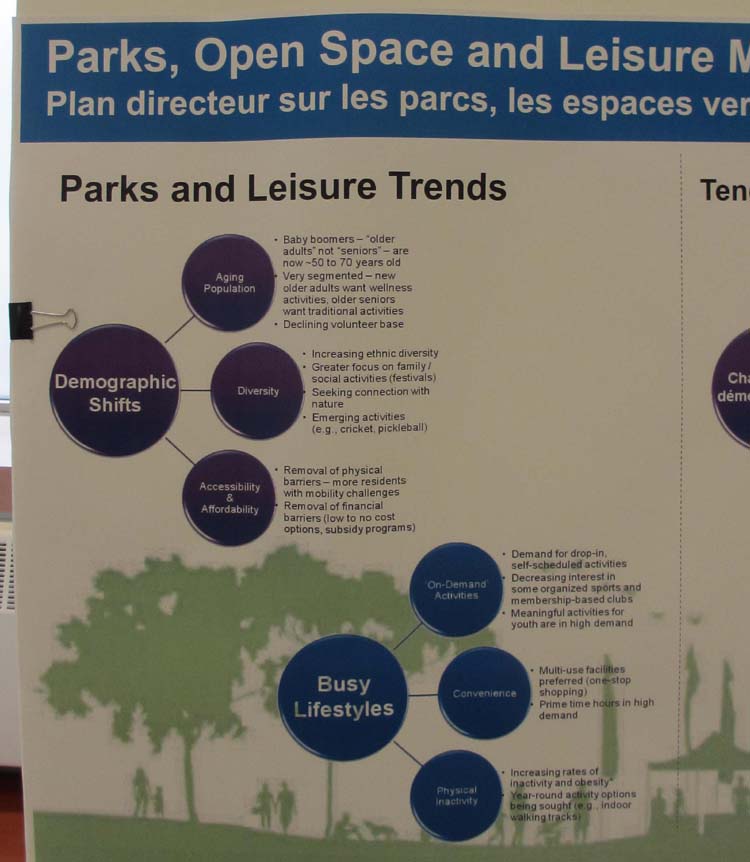
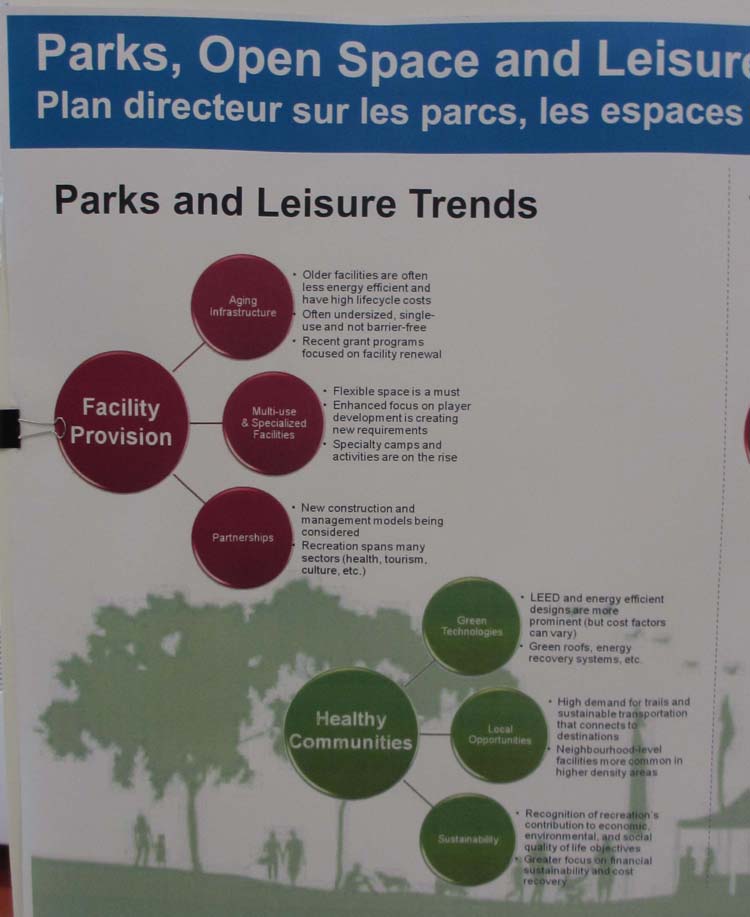
|
|
FOR A PDF PACKAGE WITH ALL OF THE CHARTS PRESENTED BY CITY
COUNCIL CLICK HERE |
| |
| |
| SUDBURY CYCLISTS UNION |
| |
| BACK TO MEET THE
CANDIDATES HOME PAGE |
| |
| |
| |
| |
| |
|